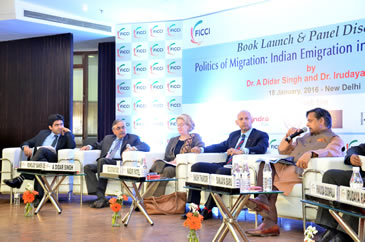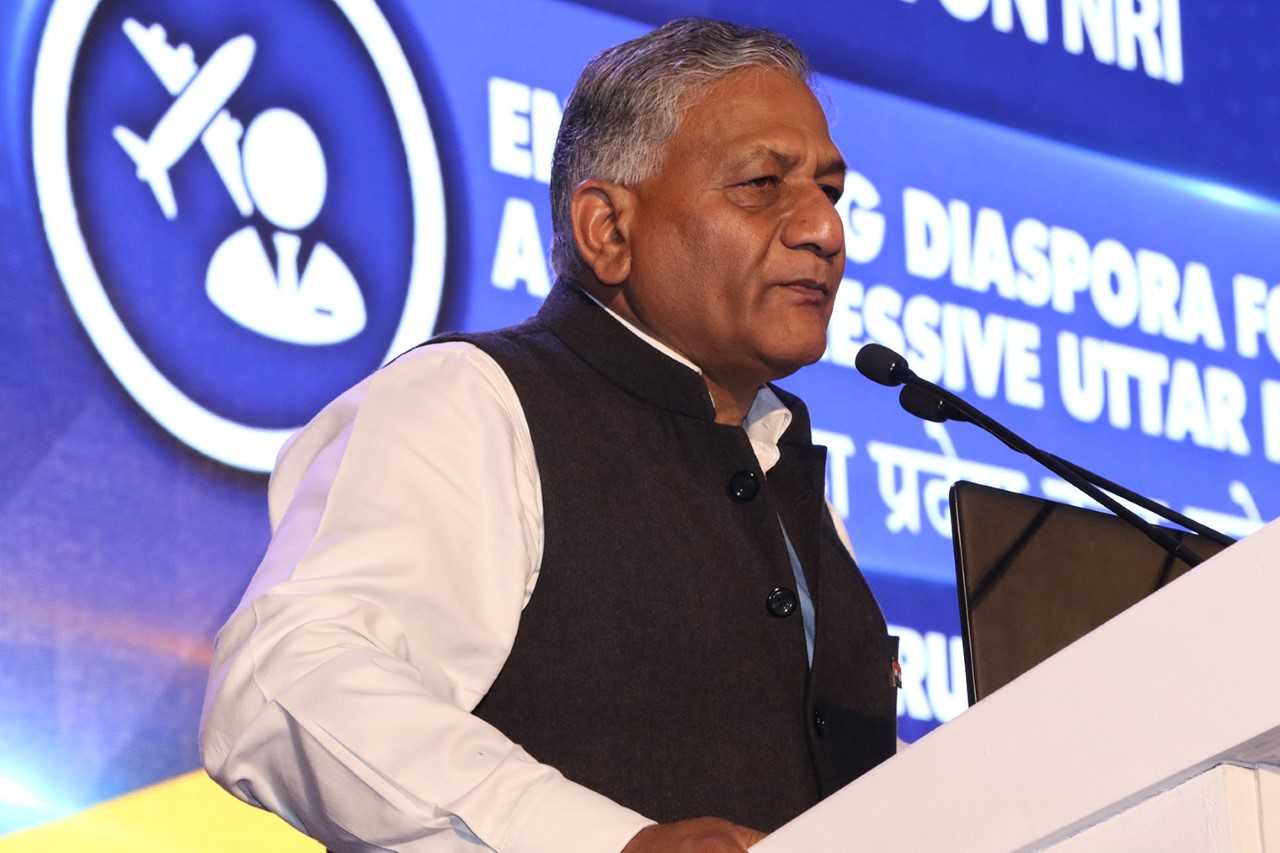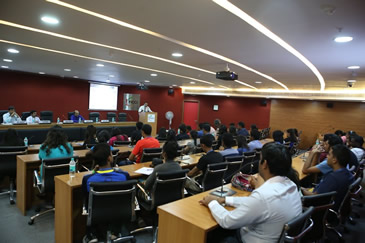Indian diaspora has never been so important to India’s economic and social development than it is today. With India galloping ahead on the back of strong economic growth enabled by strong push for economic reforms and enhanced ease of doing business, India needs to engage more with its diaspora. Indian diaspora is estimated at around 30 million and concentrated in regions such as the Middle East, United States, Malaysia and South Africa. The top countries with Indian Diaspora population include UAE, Kuwait, Oman, Bahrain, Qatar, Saudi Arabia, Malaysia, Singapore, United Kingdom, Ireland, Mauritius, United States and South Africa.
India has more than a century old history of migration. Migration is a natural, essential and growing phenomenon and is important for development of global economy and business. According to the Global Knowledge Partnership on Migration and Development (KNOMAD), World Bank there are nearly 250 million international and 750 million internal migrants who put together form nearly a billion people who have moved from their places of origin to other places. Members of Indian Diaspora are presently enjoying a dignified living in many countries while playing an important role to trace and establish connect with their roots in India.
India’s diaspora engagement efforts have helped it to receive foreign exchange remittances well over $60 billion annually, which is a significant contribution of the Indian community to their motherland. Incidentally, India tops the list of source countries for international migrants, with one-in-twenty migrants worldwide born in India. It is important to capture the potential of this large global asset for transformation and progress of India in coming times. Twenty first century belongs to India and therefore, it is important to involve Indian Diaspora as partners in India’s growth and development. It is important to note that the focus of Government of India towards Indian Diaspora has been significantly encouraging in recent years. With a laser sharp focus on engaging with and protecting the interests of its “Pravasis”, Government of India has initiated a slew of schemes targeting Indian diaspora comprising Non Resident Indians (NRIs), Persons of Indian Origin (PIOs) and Overseas Citizens of India (OCIs), who are seeking to connect with their roots in India and explore new avenues for mutually beneficial interactions, investments, technology and skills transfer, philanthropy and other emerging opportunities in the “New India”.
Indian diaspora has never been so important to India’s economic and social development than it is today. With India galloping ahead on the back of strong economic growth enabled by strong push for economic reforms and enhanced ease of doing business, India needs to engage more with its diaspora. Indian diaspora is estimated at around 30 million and concentrated in regions such as the Middle East, United States, Malaysia and South Africa. The top countries with Indian Diaspora population include UAE, Kuwait, Oman, Bahrain, Qatar, Saudi Arabia, Malaysia, Singapore, United Kingdom, Ireland, Mauritius, United States and South Africa.
India has more than a century old history of migration. Migration is a natural, essential and growing phenomenon and is important for development of global economy and business. According to the Global Knowledge Partnership on Migration and Development (KNOMAD), World Bank there are nearly 250 million international and 750 million internal migrants who put together form nearly a billion people who have moved from their places of origin to other places. Members of Indian Diaspora are presently enjoying a dignified living in many countries while playing an important role to trace and establish connect with their roots in India.
India’s diaspora engagement efforts have helped it to receive foreign exchange remittances well over $60 billion annually, which is a significant contribution of the Indian community to their motherland. Incidentally, India tops the list of source countries for international migrants, with one-in-twenty migrants worldwide born in India. It is important to capture the potential of this large global asset for transformation and progress of India in coming times. Twenty first century belongs to India and therefore, it is important to involve Indian Diaspora as partners in India’s growth and development. It is important to note that the focus of Government of India towards Indian Diaspora has been significantly encouraging in recent years. With a laser sharp focus on engaging with and protecting the interests of its “Pravasis”, Government of India has initiated a slew of schemes targeting Indian diaspora comprising Non Resident Indians (NRIs), Persons of Indian Origin (PIOs) and Overseas Citizens of India (OCIs), who are seeking to connect with their roots in India and explore new avenues for mutually beneficial interactions, investments, technology and skills transfer, philanthropy and other emerging opportunities in the “New India”.
FICCI's Engagement
The Indian diaspora has not only increased in numbers but has been gaining universal recognition for the unique contributions to its host countries. Be it entrepreneurs, workers, traders, teachers, researchers, inventors; doctors, lawyers, engineers, managers or administrators, Indian diaspora has left deep footprints through their enterprise and skills. The successes of Indian diaspora can be attributed to traditional ethos, cultural values and heritage, educational aptitude and qualifications, and diaspora’s capacity to harmonize and adapt.
India’s engagement with its diaspora is symbiotic, the strands of both sides of the relationship are equally important to create a resilient and robust bond. There is a need to strategically capitalize on our diaspora as the size, spread and the growing influence of Overseas Indians today is truly impressive. They play an active and participatory role in the economy and politics of the host nations where they reside. FICCI recognizes the importance of its diaspora and the need to involve them significantly to contribute to a “New India”.
Vision:
FICCI established a Diaspora Division, perhaps the only Industry Chamber to do so, with following objectives:
- Provide a platform to overseas Indians for engaging with resident Indians
- Productively channelize their resources and expertise, for economic growth in India
- Facilitate discussions on potential areas of collaboration on Indian Government’s social schemes
- Work with Indian Government and State Governments on Diaspora engagement initiatives
The division aims to create an eco-system with Indian Diaspora globally for cross-fertilization of ideas, knowledge sharing and resource mobilization, towards socio-economic development of India while also developing a stronger community of overseas Indians around the world.
FICCI has been associated with the India’s largest diaspora event - Pravasi Bharatiya Divas (PBD) since its first edition in 2003 when a beginning was made by the then NDA Government and FICCI to organize the first ever Pravasi Bharatiya Divas. FICCI has so far organized eight out of the fourteen editions of PBDs with Ministry of External Affairs, Government of India. It also organised Bharat ko Janiye Online Quiz and Know India Programme jointly with MEA. In our endeavour to engage with Indian Diaspora for economic, social and cultural development of States, FICCI organises State level diaspora events. The first ever Uttar Pradesh Pravasi Divas (UPPD) jointly with the Govt. of Uttar Pradesh was organised in January 2016.
FICCI through its offices overseas strengthens connects with the Indian diaspora and its organizations. It has MoUs with over 265 overseas partners including Diaspora Associations. The events undertaken by FICCI along with Central Government and State Government endeavour to effectively touch upon the key issues faced by the Indian diaspora and celebrate the contribution of Indian diaspora to the growth of global economies. FICCI considers it important to encourage participation of Indian diaspora in finding solutions to some of India’s socio-economic challenges and also facilitate platforms for promotion of investments and mutually beneficial exchanges.
Timeline
2018
2017
2016
 2015
2014
2013
2015
2014
2013
Feb
Jan
Press Release
Bringing the Diaspora Home: India's Expatriate Evacuation Operations
Oct
May
Jan

Event
Book Launch, 'The Politics of Migration: Indian Emigration in a Globalized World' and Panel Discussion on the, 'Evolution of a Diaspora Engagement Strategy'
Dec
Event
UAE Launch of Uttar Pradesh Pravasi Diwas 2016
Jun
Apr







